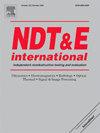Hardness detection in Friction Stir Additive Manufacturing (FSAM) based on the CEEMDAN algorithm and laser ultrasonic Spatially Resolved Acoustic Spectroscopy (SRAS)
IF 4.5
2区 材料科学
Q1 MATERIALS SCIENCE, CHARACTERIZATION & TESTING
引用次数: 0
Abstract
FSAM is an emerging high-value additive manufacturing technology. However, the variation in hardness of the formed parts due to manufacturing parameters limits its rapid development. Currently, there is a lack of effective non-contact, non-destructive testing methods for hardness in this manufacturing process. To address this, this paper employs laser ultrasonic testing (LUT) technology and uses SRAS to extract sound velocity by exploiting the center frequency of the narrow-band surface acoustic wave (SAW) generated by a pulsed laser, thereby characterizing hardness. SRAS signals from the surfaces of additively manufactured parts often suffer from significant noise. To address this, the Complete Ensemble Empirical Mode Decomposition with Adaptive Noise (CEEMDAN) algorithm is applied. This algorithm decomposes the noisy raw signal into a series of Intrinsic Mode Functions (IMFs). Subsequently, the modes primarily containing the signal are selected using the correlation coefficient for reconstruction, thus achieving de-noising of the raw signal. Simulation and experimental results show that this algorithm can extract the corresponding center frequency and SAW velocity from SRAS signals with a low signal-to-noise ratio. Comparison with hardness test results indicates that the SAW velocity and center frequency effectively characterize changes in sample hardness. In linear regression analysis, a coefficient of determination () is exhibited.
基于CEEMDAN算法和激光超声空间分辨声光谱(SRAS)的搅拌摩擦增材制造(FSAM)硬度检测
FSAM是一种新兴的高价值增材制造技术。然而,由于制造参数的影响,成形件的硬度变化限制了其快速发展。目前,在这种制造过程中缺乏有效的非接触、无损的硬度检测方法。针对这一问题,本文采用激光超声检测(LUT)技术,利用SRAS利用脉冲激光产生的窄带表面声波(SAW)的中心频率提取声速,从而表征硬度。来自增材制造零件表面的SRAS信号通常受到显著噪声的影响。为了解决这个问题,应用了自适应噪声的完全集成经验模态分解(CEEMDAN)算法。该算法将带噪声的原始信号分解为一系列内禀模态函数。随后,利用相关系数选择主要包含该信号的模态进行重构,从而实现原始信号的去噪。仿真和实验结果表明,该算法能以较低的信噪比从SRAS信号中提取出相应的中心频率和声表面波速度。与硬度测试结果的对比表明,SAW速度和中心频率能有效表征样品硬度的变化。在线性回归分析中,具有决定系数(R2=0.982)。
本文章由计算机程序翻译,如有差异,请以英文原文为准。
求助全文
约1分钟内获得全文
求助全文
来源期刊

Ndt & E International
工程技术-材料科学:表征与测试
CiteScore
7.20
自引率
9.50%
发文量
121
审稿时长
55 days
期刊介绍:
NDT&E international publishes peer-reviewed results of original research and development in all categories of the fields of nondestructive testing and evaluation including ultrasonics, electromagnetics, radiography, optical and thermal methods. In addition to traditional NDE topics, the emerging technology area of inspection of civil structures and materials is also emphasized. The journal publishes original papers on research and development of new inspection techniques and methods, as well as on novel and innovative applications of established methods. Papers on NDE sensors and their applications both for inspection and process control, as well as papers describing novel NDE systems for structural health monitoring and their performance in industrial settings are also considered. Other regular features include international news, new equipment and a calendar of forthcoming worldwide meetings. This journal is listed in Current Contents.
 求助内容:
求助内容: 应助结果提醒方式:
应助结果提醒方式:


